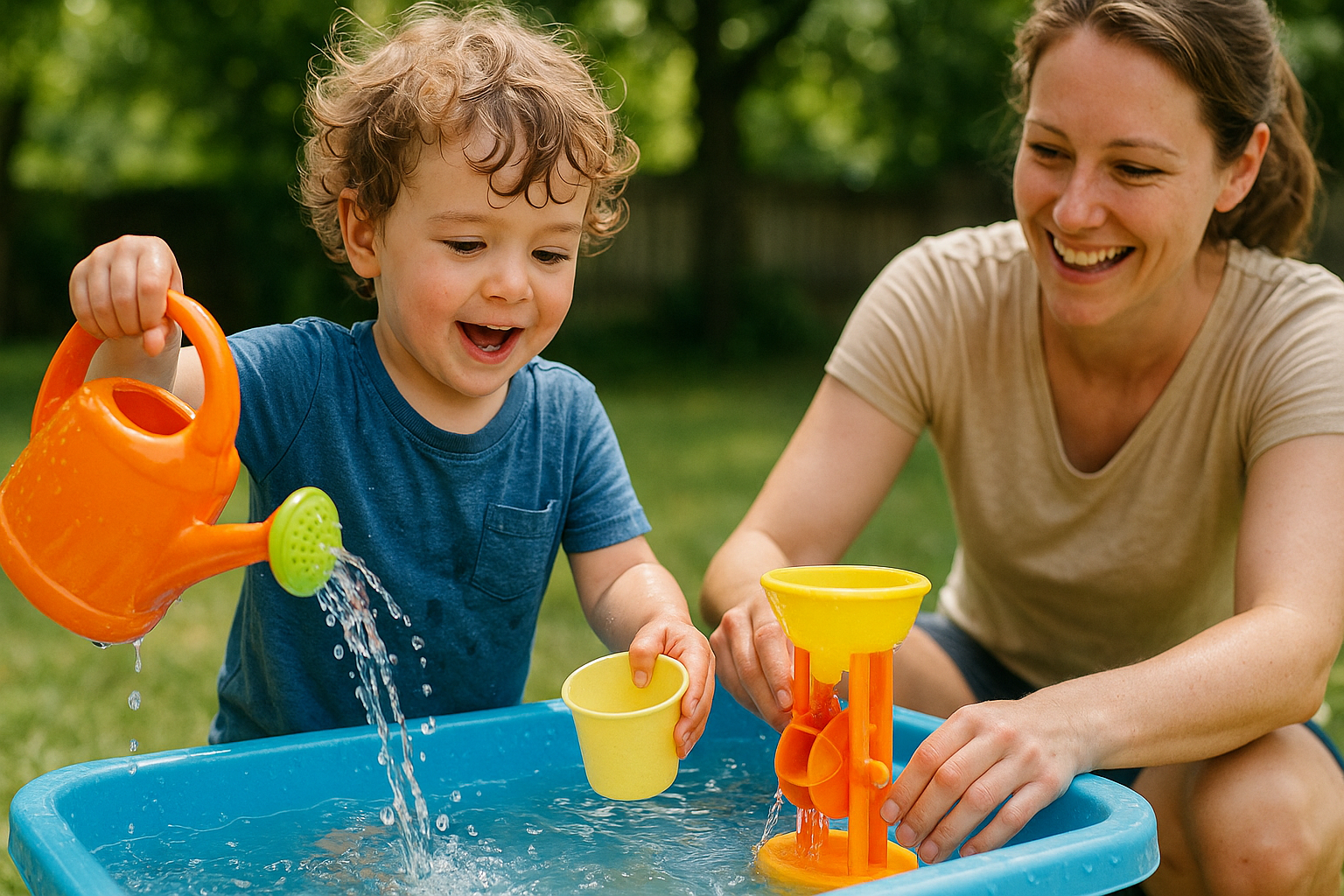When the sun is blazing and your child’s energy is high, water play becomes the perfect solution. It cools them down, keeps them entertained, and—most importantly—offers countless learning opportunities. Water activities are sensory-rich and ideal for children between the ages of 2 and 6. With a few simple supplies, your home can become a summer-friendly learning lab.
Why Water Play Is So Valuable
Water play does more than splash and giggle. It supports:
- Fine and gross motor development: Pouring, scooping, squeezing.
- Science and math skills: Measuring, experimenting, comparing.
- Language development: Describing textures, temperatures, and actions.
- Sensory integration: Engaging touch, sight, sound, and sometimes smell.
- Emotional regulation: Water has a naturally calming effect.
With just a basin and a few tools, water becomes a medium for focused, engaged learning.
Safety First
Before diving in (literally), set a few basic rules:
- Always supervise water play, even with shallow amounts.
- Use non-slip mats if playing indoors or on tile.
- Check water temperature to ensure it’s safe and comfortable.
- Limit slippery surfaces and avoid glass containers.
Now, let’s get into the fun!
Simple and Educational Water Activities
1. Pouring Station
Materials: Cups, funnels, pitchers, bowls.
Setup: Fill a few containers with water and let your child pour from one to another.
Learning Benefits:
- Builds hand-eye coordination
- Teaches concepts like “empty” and “full”
- Introduces basic measurement
2. Sink or Float Experiment
Materials: Random household objects (plastic spoon, coin, sponge, toy car).
Setup: Fill a large bowl or small tub with water. Let your child predict which items will float or sink.
Learning Benefits:
- Scientific thinking (hypotheses and testing)
- Observational skills
- Understanding of density and weight
3. Ice Excavation
Materials: Freeze small toys in ice cubes or larger molds.
Setup: Let children dig the items out using spray bottles with warm water, spoons, or pipettes.
Learning Benefits:
- Patience and problem-solving
- Understanding temperature and melting
- Fine motor control
4. Color Mixing Lab
Materials: Food coloring, water, plastic cups, pipettes or eyedroppers.
Setup: Let kids mix colored water to see how colors change when combined.
Learning Benefits:
- Basic color theory
- Cause and effect
- Creative expression
5. Water Transfer with Sponges
Materials: Two bowls, one with water, one empty; large sponge.
Setup: Challenge your child to move water from one bowl to the other using only the sponge.
Learning Benefits:
- Strengthens hand muscles
- Teaches absorption
- Focuses on effort and persistence
6. Wash the Toys
Materials: Soapy water, small tub, old toothbrush or sponge, dirty toys.
Setup: Let children give their toys a bath.
Learning Benefits:
- Encourages responsibility and self-care routines
- Sensory exploration
- Pretend play
7. Floating Art
Materials: Paper, markers, dropper, water, and tray.
Setup: Color shapes with dry-erase markers on a plastic tray, then drip water and watch shapes float.
Learning Benefits:
- Observation of water tension
- Cause-effect exploration
- Exciting visual play
Incorporating Learning Through Language
Use every activity to boost vocabulary and communication. Ask:
- “What does it feel like?”
- “Can you describe what’s happening?”
- “Why do you think it floated?”
- “How can we make it sink?”
Give your child new words like soak, drip, absorb, dissolve, evaporate—and use them in context.
Math Through Water Play
Don’t underestimate water’s power for introducing early math concepts:
- Counting scoops or drops
- Comparing quantities
- Timing races with pouring
- Estimating volume
Add measuring cups and challenge your child: “Which cup holds more?” or “How many scoops does it take to fill this?”
Science Concepts in the Splash
Water play naturally supports exploration of:
- Temperature (warm vs. cold)
- State of matter (solid ice vs. liquid water)
- Movement (waves, currents, flow)
- Evaporation (observe wet spots drying over time)
All of this creates the groundwork for more advanced science learning later.
Extend the Learning with Books
Pair water play with water-themed books like:
- Water by Frank Asch
- Float by Daniel Miyares
- Over and Under the Pond by Kate Messner
- The Magic School Bus at the Waterworks by Joanna Cole
After reading, relate the story to your activities. Ask: “Can we try what the character did?”
Ideas for Indoor vs. Outdoor Water Play
Indoor Options:
- Use the bathtub or kitchen sink
- Put down towels under a plastic tub
- Use suction-cup toys or shower-safe items
Outdoor Options:
- Kiddie pool
- Water balloons
- Sprinklers
- Water table or large plastic bin
Adapt your setup to your space and comfort level.
Clean-Up = More Learning
Involve your child in wiping up spills and putting toys away. It teaches:
- Responsibility
- Sequencing steps
- Ownership of their environment
Sing a clean-up song to make it fun and consistent.
Wrapping Up: Water Play Is Learning Play
Water activities are not just summer fun—they’re science labs, math lessons, and vocabulary builders disguised as play. With simple tools and a little planning, you can help your child cool off while building real skills. Best of all, the laughter and discovery make lasting memories.
